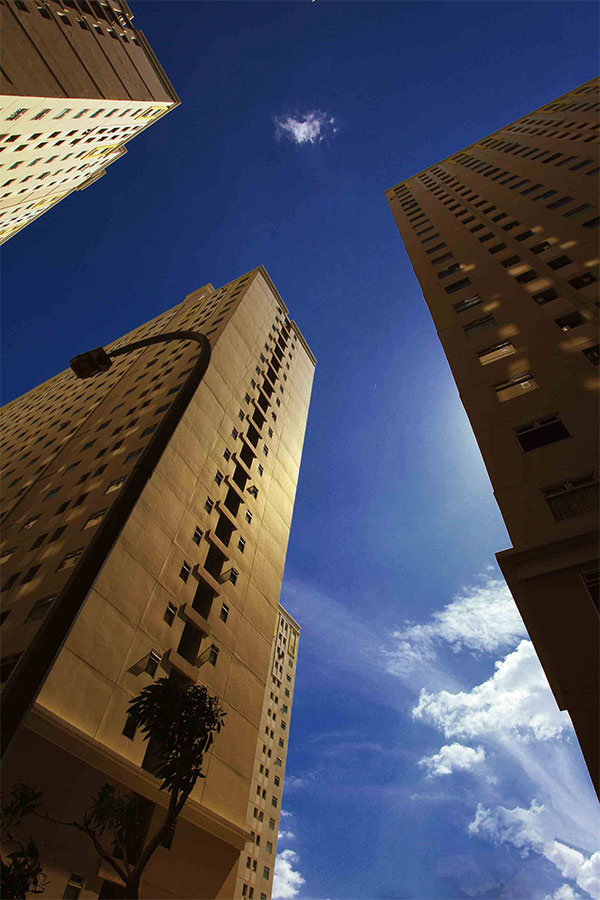Just like a well-trained performance dancer, a photographer's best work comes only after rigorous practice, trial and error, and techniques.
For architectural works, proficiency in basic light painting is essential as it directs the viewers' attention. The way you control and play with lightiing, amongst other techniques, will elevate photos with more depth and realistic dimensions.
Capturing the light is the principal technique in any genre of photography and it trains our awareness in shooting any shape and type of the object. However, playing with the light in architectural photography require more practice.

EOS 5D Mark II; EF17-40mm f/4L USM; 17mm; f/11; 62 sec; ISO-100 (Marina Bay)
Back in the day, I did not understand why people were so concerned about lighting. I always believed that composition was more important until I tried macro photography and I could not forget what my friend said to me, “Shooting macro without incorporating light will result in ordinary pictures”. From that moment, I started to explore light in my architectural photos as I now believe that lighting is the spirit of every photo.
Before we learn more about how to incorporate light in architectural photos, learn all about the basics of architecture photographer from below:
Architectural Photography #1: 3 Basic Concepts
Architectural Photography #2: Using Wide-angle/Telephoto Focal Lengths
Architectural Photography #3: Effective Composition Techniques
Architectural Photography #4: Photographing Buildings at Night
Composition, Composition, Composition!
I understand that this topic might not be interesting for fellow enthusiasts who regularly read books about photography. However, architecture is not all about composition. The harmony of multiple components – symmetry, flow, rhythm, contrast, and light – is what makes each photo appealing to the audience.

EOS 5D Mark II; EF8-15mm f/4L Fish Eye USM; 15mm; f/8; 1/100 sec; ISO-1250 (Rhytm)
Angle determines the composition, and composition determines the harmony of a photo. Harmony is a balanced unification from an object that we shoot using the desirable angle.
A balanced composition does not always mean a symmetric one. Something that is symmetrical must be balanced, although balance is not always symmetric. Being symmetrical is a matter of proportional distribution of visual weight.

EOS 5D Mark II; EF17-40mm f/4L USM; 17mm; f/8; 0.3 sec; ISO-1000 (Let's Dancing Rock)
There are two concepts of balance in art, symmetrical and asymmetrical. Symmetrical balance is known by the concept of an evenly distributed elements around a central point or axis. Symmetry is easier to understand as its concept is mostly found in traditional old architecture such as a king palace. Applying the symmetrical composition in this type of object is relatively easy as most of the historical building have a balanced proportion between left and right surface.

EOS 350D; EF-S18-55mm f/3.5-5.6 IS STM; 18mm; f/14; 1/500 sec; ISO-320 (Infinity Chapel)
Position yourself in the middle where you are able to equally divide the object. It is simple and easy. However, in a theory, the result tends to be dull and repetitious. You can create a dynamic balance when you shift the angle of the building to form two perspective distortion.

EOS 5D Mark II; EF17-40mm f/4L USM; 17mm; f/16; 1/100 sec; ISO-100 (Cross Light)
Now let’s have a look at the BALANCE COMPO illustration that I made. I like to use this to give in-depth understanding about composition. Pay attention to the asymmetrical balance section. Both of the sides looked balanced despite having different shape. Notice the color of each object where the darker color gives more weight than the lighter one.

Balance is not only about being symmetrical but also involves weight (color / dark or light), measure, density, and shape (visual effect of the shape such as lean object perceived as light as opposed to a cube). Do apply this to your practice.

EOS 5D Mark II; EF8-15mm f/4L Fish Eye USM; 15mm; f/7.1; 1/40 sec; ISO-1600 (Venetian)

EOS 5D Mark II; EF17-40mm f/4L USM; 40mm; f/8; 1/250 sec; ISO-100 (Pray)
Asymmetrical composition is causally explained as an equally distributed weight despite different appearance. When we take a photo of a building using 2 TH perspective, you must create the balance between each side albeit the different shape. You can find it when you pay attention to the visual effect of the shape, colors, and lighting.

EOS 5D Mark II; EF17-40mm f/4L USM; 17mm; f/8; 1/25 sec; ISO-640 (Green Accent)
Dance with the rhythm of composition, dive into the beauty of it.

EOS 5D Mark II; EF17-40mm f/4L USM; 24mm; f/20; 53 sec; ISO-100 (Rotation)
Learn more about architecture photography from the below articles:
Architecture Photography from Different Perspective
10 Dream Skyscrapers to Photograph
An Architectural Heritage Tour Through Photography
Receive the latest update on photography news, tips and tricks.
Be part of the SNAPSHOT Community.
Sign Up Now!About the Author
A person whose hobby is photography. Lives in Bandung, West Java. Specialized in architectural photography. Also likes landscape, stage photography, and animal photography. He has written several books published by Elexmedia and is now active in giving workshops of architectural photography in some cities of Indonesia



































